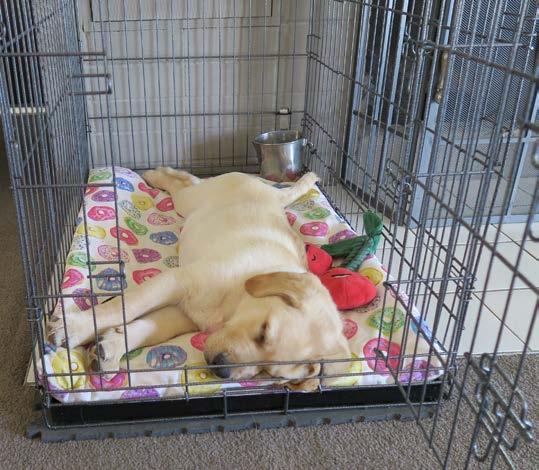
9 minute read
Crate Training
– Craig A Murray When sitting down and giving some serious thought on kennel crating, it’s amazing how the suggestion of it to friends and especially clients can be so easy or impossible to convince them it is both good and natural. My family has always had dogs as far back as my memory will allow. In fact my involvement with dogs goes back even further and is supplemented by my parents always saying I learn’t to walk by holding onto the German Shepherd they owned at the time. I cannot confirm this as my memory does not go back that far, but it is a great story for a person whom always wanted to be a dog trainer and now gets to do exactly that internationally. My memory does go back to my very first dog at about age 9-10 and as was the case for the majority of all pet dogs back then, he lived in the backyard and it was a definite that he had to have a kennel.
My Dad spent a whole weekend building him a dog house/ kennel or if you like the equivalent to a kennel crate without a door. I am convinced that my father had no science or even much reasonable thought as to why he would spend a whole weekend building this for my dog other than to say one of his favourite justifications to everything, ‘Y is a crooked letter and B is no better’, just because I said it works….dogs love kennels. His verbal justifications were truly feeble, but the fact that this dog and almost every dog I have owned or trained in home or in kennel over the last 4 or more decades really has strengthened dear old Dad’s credibility on ‘Dogs love kennels’.
Stretching my memory back to think about the thousands of times over this period that I have seen all pure breeds of dogs and their cross breeds (from teacup size to the largest) most have a special place they like to go and get inside somewhere that was more covered or closed in. If not closed in they seek out under things such as beds, coffee tables, up behind lounges or furniture, under cars, caravans, trailers and BBQ’s, sometimes under stairs and verandas. Dogs are now much more accepted inside the house – often inside closets and cupboards. This alone has me confident that this is generally natural, normal and comfort behaviour for most dogs.
A justifying point my wife uses to help people to become more comfortable with the crating process is to say most humans prefer to sleep in a bedroom rather than out under the stars all the time. When the homeless population are asked how do you feel having to sleep out in the open the greater majority report feeling very vulnerable and worried about their safety. Often they will seek out areas that are very similar to those that dogs would accept and
when asked why that particular spot, the answer is it offers me some barrier or concealment from both bad things happening such as safety issues and from the elements. Even people whom love the great outdoors generally still utilise tents or even swags to get a place that offers this small comfort with very few just wanting to lay out in the open.
If you ask most people ‘Why do you not want to crate your dog?’, ‘What is the rationale behind your opinion?’ most will say if they are truthful ‘I don’t feel comfortable doing this to my dog’, ‘I would never put my dog in a jail’, ‘I feel like it is cruel’ or ‘I am scared my dog won’t like me anymore’. For me these days, if the former information is still not enough validation for the person to consider the crating option, I would just say to them to please consider this last point in the name of true welfare! If an unfortunate accident, injury or illness were to occur to your dog and it absolutely had to have a prolonged stay at a veterinary facility for its ongoing life or best care option, do you think to now have to deal with the incident and its associated negative aspects would be a stressful situation and would your dog now also have the unnecessary magnified stress of having to learn, adjust and deal with the crating situation which could easily have been conditioned previously in a positive manner. If this is not enough for them now to consider crating I do not persist any further with my line of trying to give them any further justifications.
I am definitely a big advocate of the crating technique for the following reasons:
Transporting groups of newly born puppies for check-ups and vaccinations is safer and easier in a crate. When our pups are born they are in a whelping box and once they have reached the mobile and active stage we put a kennel crate with the door either off or fixed back so it can’t be accidentally closed in their run and they can decide to go in it willingly. Naturally we also entice this behaviour by including in there the best and comfiest bedding and interesting toys and objects to play with. Feeding is another one of our enticing ploys and we love it when we can orchestrate the pups or dogs feeling this is their own best benefit decision.
Once they are all happy choosing to sleep in the crate we then again organise them having timed play to coincide with assured toileting and then feeding in a couple of crates – usually wire so they can still have the visual togetherness. Now we start to close the doors so when they stir or wake they get used to being in a closed crate. Naturally very soon after waking we get them out to try to start conditioning so they find it foreign to toilet in there and we aim for being clean. Once this is done almost all pups will be comfortable in a crate. All our dogs are generally transported in crates and when we go to all manner of functions we also have a crate for their rest time comfort. After doing probably hundreds of public demonstrations, we in the early days, realised our dogs are extremely happy to go away from the public and the constant attempts of interaction as it can be very taxing and they actively seek time in their kennels. Over the years I have often had to fly away with our specialist man trailling Bloodhounds and cadaver dogs. The crates they fly in often also have to double as their day to day transport crates and their night time bedrooms. When I was at Bowral with my dog Narcs for the backpacker murders in the Belanglo Forrest search for over 5 weeks part of the time he was in hotel rooms with me in his crate and part of the time in the Bowral police station cells. Being comfortable with crating was imperative for great success in high pressure, long duration and arduous search environments. This is a situation that has occurred dozens of times with our detection dogs and we always condition our dogs to love their crates. We use crates for the important job of teaching puppies to be house trained and usually by the 10th week of life the majority of all our pups will all sleep overnight approximately 8 hours without accidents. Start the process early and then once

• Transcervical insemination with fresh, chilled and frozen semen. • Semen collection and freezing. • In-house progesterone testing - results in 20 minutes. • Dog and bitch fertility assessment and much more.






Dr Scott Norman BVSc PhD DACT Registered specialist - veterinary reproduction Dr Jennifer Larsen BVBiol BVSc Ph (07) 3204 4332 1474 Anzac Ave Kallangur 4503
split, the crate is used to limit access to the house until after confirmed toileting has occurred. Every time the pup wakes from sleep, after a drink or feeding or displays any restlessness they are taken out to relieve themselves. If they do not successfully fully toilet they are back into their crate and repetition of opportunity to toilet is given on the same aforementioned process until success is achieved. This now signals free time in the house under extreme vigilance so no accidents occur. This is also the time for early play conditioning, shaping house rules or further outside exploration time and play with others. Because all of our dogs these days are either extremely high drive working dogs or guide, hearing and assistance dogs the rule of all things starts and finishes with calm and collective behaviour which is also applied to the crate conditioning process – including the food being prepped and delivered.
Another really important factor for us is with all these extremely high drive and high energy dogs they could be extremely taxing to have around should you not condition them in calm and measured behaviour and the crating and our signature stationing (mat training) techniques together make our extreme dogs act and look like lounge lizards. Often when we go with our dogs to do demonstrations many times people will comment on how calm and considerate our dogs are only to receive a real shock at the explosion of drive, energy and desire to work they display when given the cue to work.
There are many other great points about crating but it would be a small book rather than an interest article so I am going to close on the last point which we have already mentioned – that of accident, injury or illness and needing to have your dog sedated for its best welfare. This is one point I have seen many people whom thought this would never happen to them agonise over when the unfortunate and very distressing time comes and it is for both species and often spills over to families whom feel the distress when the dog does not cope.
I believe crating is one of the most important and beneficial training phases that can be done. Unfortunately humans can be very emotional and allow their emotions to rule rational thinking or have an agenda and usually it is not always the story they so strongly advocate. Welfare is a wholistic approach and covers both good and bad times or it may just end up being warfare instead.








